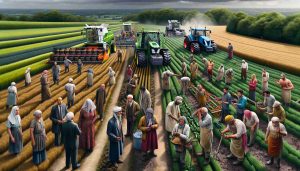Artisanal Workshops Found Throughout the Region
3 min read
Small-scale artisanal workshops can be spotted at every corner of the region, showcasing the diverse craftsmanship and creativity of local artisans. These workshops serve as hubs of innovation and tradition, blending modern techniques with age-old practices to produce unique works of art.
From woodworking studios to pottery ateliers, the region’s artisanal workshops offer a glimpse into the rich cultural heritage and skilled craftsmanship that defines the area. Visitors have the opportunity to witness artisans at work, shaping raw materials into exquisite pieces that reflect the essence of the region.
Each workshop tells a story, not just through the final products on display, but also through the passion and dedication of the artisans behind them. Whether it’s intricate hand-woven textiles or intricately carved wooden sculptures, these workshops are a testament to the creativity and talent embedded in the region’s cultural fabric.
Exploring these artisanal workshops is not just a visual delight but also a chance to support local artists and craftsmen in their pursuit of preserving traditional art forms. The next time you find yourself in the region, make sure to visit these hidden gems to experience firsthand the artistry and craftsmanship that make this area truly unique.
Artisanal Workshops Found Throughout the Region Unveiled: Delving Deeper
Small-scale artisanal workshops dotted across the region offer a deeper insight into the vibrant tapestry of local craftsmanship, going beyond the surface to reveal hidden gems of artistic expression. Amidst the hustle and bustle of urban life, these workshops stand as oases of creativity, where tradition meets innovation in each carefully crafted piece.
Key Questions:
1. How do artisanal workshops contribute to the preservation of cultural heritage in the region?
2. What challenges do local artisans face in sustaining their craft in the modern world?
3. What role do these workshops play in promoting sustainable practices and ethical consumption?
Answers and Insights:
1. Artisanal workshops are vital in safeguarding traditional art forms and knowledge passed down through generations, ensuring these heritage crafts continue to thrive amidst globalization.
2. Local artisans often grapple with issues such as limited access to resources, competition from mass-produced goods, and the need to adapt to changing consumer preferences while staying true to their craft.
3. These workshops highlight the importance of supporting ethical production methods, environmental sustainability, and fair trade practices, fostering a deeper appreciation for the value of handmade goods.
Advantages and Disadvantages:
– Advantages: Artisanal workshops provide a platform for artisans to showcase their unique skills, offer personalized and authentic goods, and contribute to the local economy and cultural identity.
– Disadvantages: Challenges such as limited market reach, pricing competitiveness with mass-produced items, and struggles to balance traditional techniques with contemporary demands pose hurdles to sustainable growth for these workshops.
Explore the intricate blend of tradition and innovation at these artisanal workshops, where each piece carries a story waiting to be discovered. Support local artists and craftsmen in their dedication to preserving the region’s cultural heritage, one masterpiece at a time.
For more information on artisanal craftsmanship and cultural heritage in the region, visit link name.






